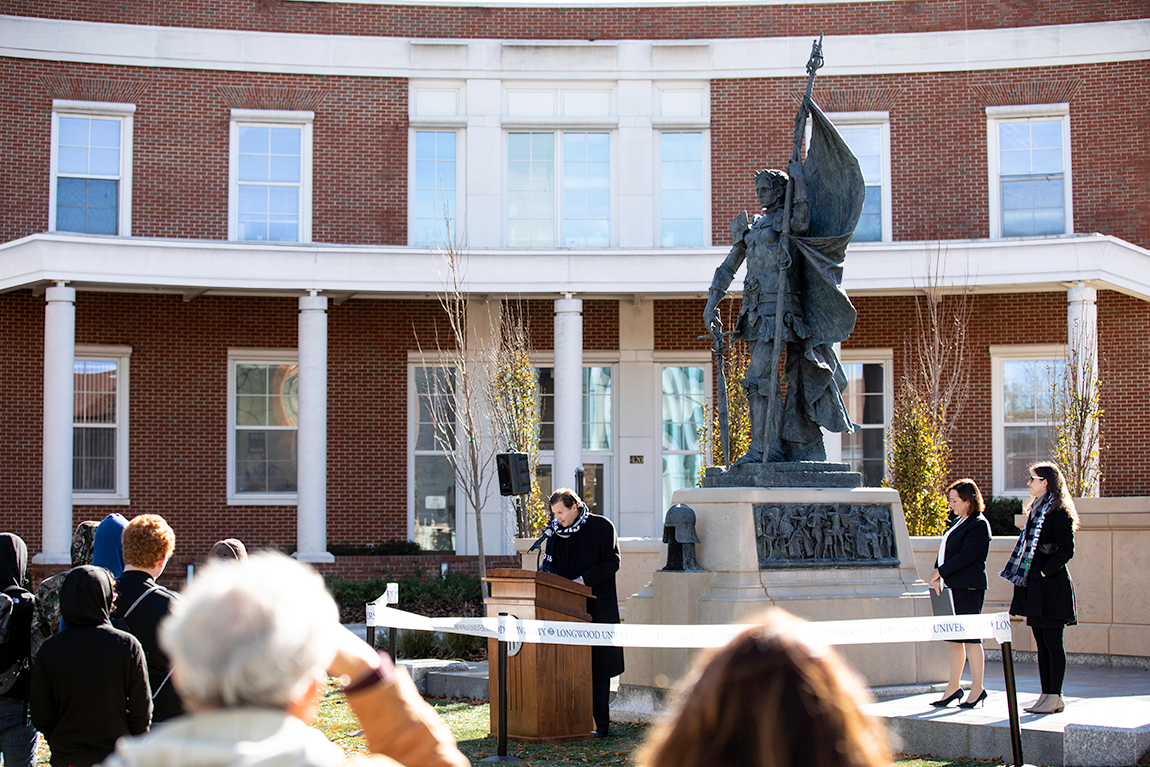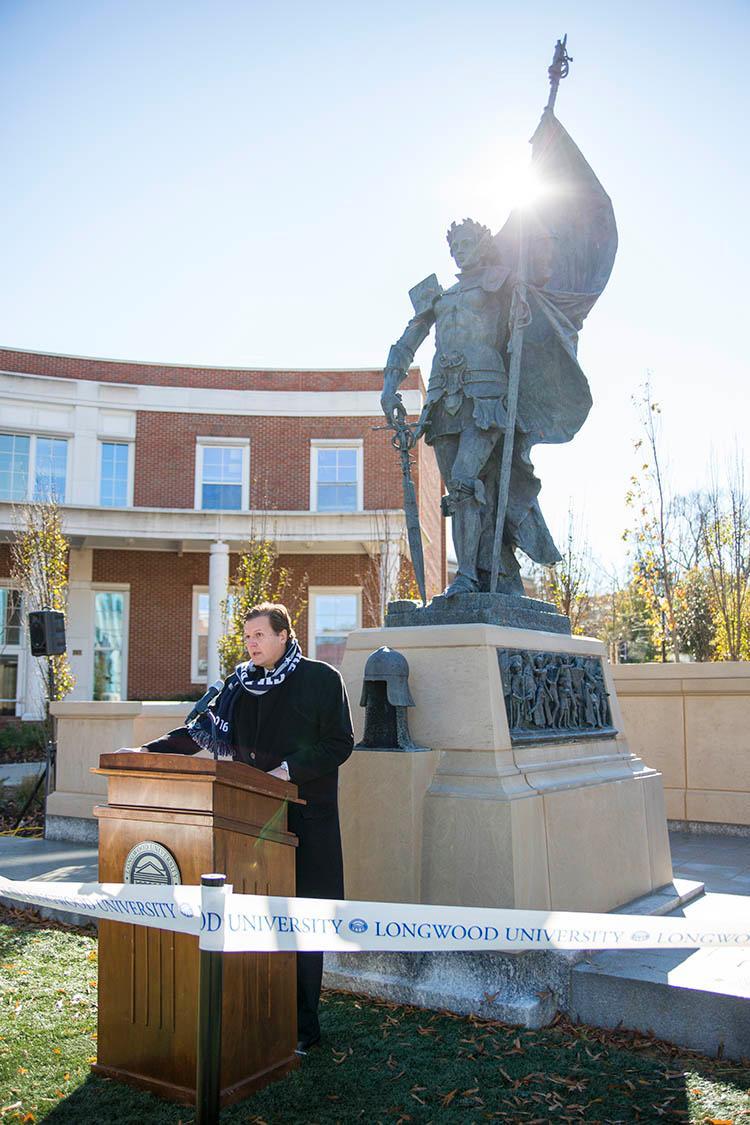

Longwood’s leading lady has a new look.
The campus community gathered on a brisk Friday morning to get the first up-close look at Longwood’s towering new monument to Joan of Arc, the university’s patron hero who has inspired generations of students. The monument, Longwood’s third of the 15th-century French heroine, was installed Monday after more than three years of work by a renowned Scottish artist.
“A great work of art endures through time and inspires across horizons of years difficult to fathom,” said Longwood President W. Taylor Reveley IV, as he and Rector Marianne Radcliff ’92 dedicated the monument. “This majestic statue that we dedicate today will inspire us across all our years: Joan of Arc, poised forever young, in a moment of defiant triumph. She will see untold wonders as well as grief and woe, and stand as a point of reverence and hope for people who have long forgotten the work of the year 2018 that brought her here.”
New Joan of Arc Statue | Longwood University
At more than 15 feet tall, the heroic figure of Joan of Arc strikes an assertive pose and captures the historic woman at the height of her military prowess, raising the Siege of Orleans in 1429. Wearing a heavy suit of fanciful armor and wielding not only a legendary sword but also the French standard she is said to have favored, this vision of Joan of Arc stands in stark contrast to softer images of her in museums around the world. It stands at the southern end of Brock Commons, between Hull and Bedford halls.
“This vision of Joan of Arc embodies the spirit of Longwood, of our university, as we look out over the 21st century and beyond with our special call, with all we have been given in lives of citizen leadership,” said Reveley. “Joan of Arc here embodies the resolute and revolutionary grace that animates the alma mater.”
The new statue of Joan of Arc joins two other representations of the heroine, both prominent fixtures on campus. Known affectionately as Joanie on the Stony and Joanie on the Pony, they reside in Ruffner Hall, where hundreds of students pass each day, and have come to be known as much as symbols of Longwood as depictions of the legendary figure.
This majestic statue that we dedicate today will inspire us across all our years: Joan of Arc, poised forever young, in a moment of defiant triumph.
Longwood President W. Taylor Reveley IV Tweet This
Radcliff recalled her own relationship with Joan of Arc, first cultivated as a child in Sunday school, growing as a Longwood student and deepening since then.
“As tragic as her ending was, tried for witchcraft, heresy and dressing like a man of all things, her accomplishments are nearly unmatched,” said Radcliff. “She taught me what’s possible. It’s a concrete lesson that tasks that seem insurmountable aren’t necessarily so. That because people say you cannot is no reason to turn back. These are the life lessons worth learning.”
As the ceremonial ribbon was cut, more than a hundred people in attendance crowded around the granite-and-limestone exedra, marveling at the figure’s intricate details.
Earlier in the week, sculptor Alexander Stoddart traveled to Farmville from his studio in Scotland to supervise the statue’s installation and deliver a lecture on the inspiration for and production of the figure.
“Strange things happen within the monument,” the artist said in his Monday night lecture in Blackwell Ballroom. “For instance, the flagpole has this strange twist going up it—various whiplashing actions. Everything in this monument has to be seen to have a life of its own, or at least a will or a tension of its own. Her hands are nude, but come out of a gauntlet. This is fairy sculpture, really. It’s all supernatural—it’s an image of the fairy queen that can stand for so many types of Joan of Arc.”
Q&A: Famed sculptor Alexander Stoddart talks about inspiration for Joan of Arc monument
Stoddart is one of the world’s foremost neoclassical monumental sculptors. He has been active since the early 1980s, but began working on public monuments about a decade later. Some of his most celebrated pieces are of philosophers Adam Smith and David Hume, which stand in the Scottish capital, Edinburgh, Stoddart’s hometown.
In 2008, he was named the Queen’s Sculptor in Ordinary in Scotland, a lifetime appointment and the highest honor a Scottish artist can receive. In 2012, he was elected a Fellow of the Royal Society of Edinburgh. The historic figures in his monuments often take on a heroic realism, with noble postures and metaphoric elements.
The new monument was conceived during the 2015 Master Plan as a nod to Longwood’s history of public art along Brock Commons and longstanding relationship with Joan of Arc. As conversations continued, word made it to Stoddart that Longwood was considering the project. The sculptor was immediately intrigued by the idea.
“It has to give a shock,” he said. “What we’re fed up with doing is compliant sculpture. Sculpture that wouldn’t say boo to a goose. Because what we’re dealing with are images of people that said a mighty boo to a goose. Joan of Arc, if she had been a compliant creature, wouldn’t have gotten anywhere.”
His vision was immediately of the androgynous, assertive figure that now stands on Brock Commons. During his lecture, he acknowledged the differences between his Joan of Arc and other representations of the inspirational woman, especially in some of the more masculine elements of the monument including her codpiece and muscular, imposing frame.
“If we object to this on the bounds of decency, whose side are we really on?” he asked. “Her trial is one of the most documented trials of all. She’s accused of heresy, witchcraft, insubordination, insurrection—the whole gamut. But the one point they keep coming back to her on was the fact that she refused to wear women’s clothes. She insisted constantly on wearing men’s clothing. If we object to these decisively masculine details, we are taking the side of her accusers.”
As university traditions go, Longwood’s devotion to Joan of Arc is remarkable in its endurance.
In the early 1900s, as many around the world marked the 500th anniversary of her birth, Joan of Arc became a special symbol for the university, anchored by a gift from the class of 1914, a plaster cast of a Henri Chapu sculpture that is now affectionately known on campus as Joanie on the Stony. Some attribute the idea to a graduation speech by class president Maria Adams Bristow Starke, in which she urged classmates to take inspiration from the French heroine. Others point to longtime English professor Dr. James Grainger as making the initial suggestion that Joan of Arc become a symbolic figure for what was then a normal school.
The relationship that began in 1914 was further solidified in 1927 when another Joan of Arc sculpture was purchased, this time a recast of Anna Hyatt Huntington’s celebrated work, which has been called “one of the finest equestrian monuments in the United States.” In keeping with tradition, the student body has referred to her as Joanie on the Pony ever since.

In his remarks at Friday’s dedication, Reveley noted that powerful thread running through generations of Longwood students. To the current Longwood students in attendance, he issued a call to remember and draw inspiration from Longwood’s patron hero.
“In your lives and careers, as you create and sustain and lead communities, think of the power of beauty itself to inspire, and galvanize and weave it into your work,” he said. “And for fortitude, and to fill the soul throughout all the years, you can return to the alma mater, to the very place we stand now, consecrated with the presence of our patron hero who in the midst of victory remains inaccessible to vanity and hate, who in the midst of popular enthusiasm lives in humility and prayer, who in the universal crush of ambition covets neither profit nor honors.”
